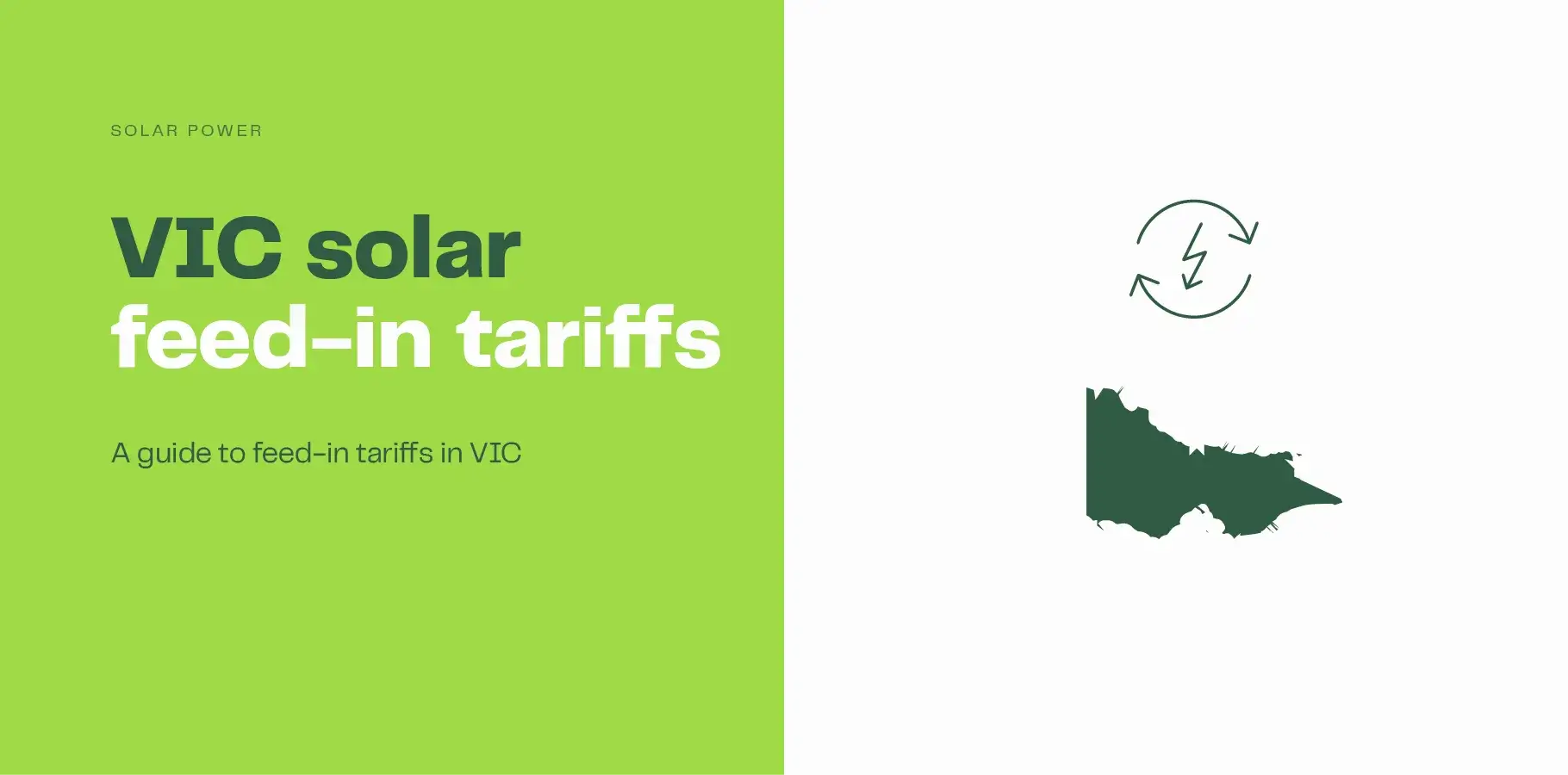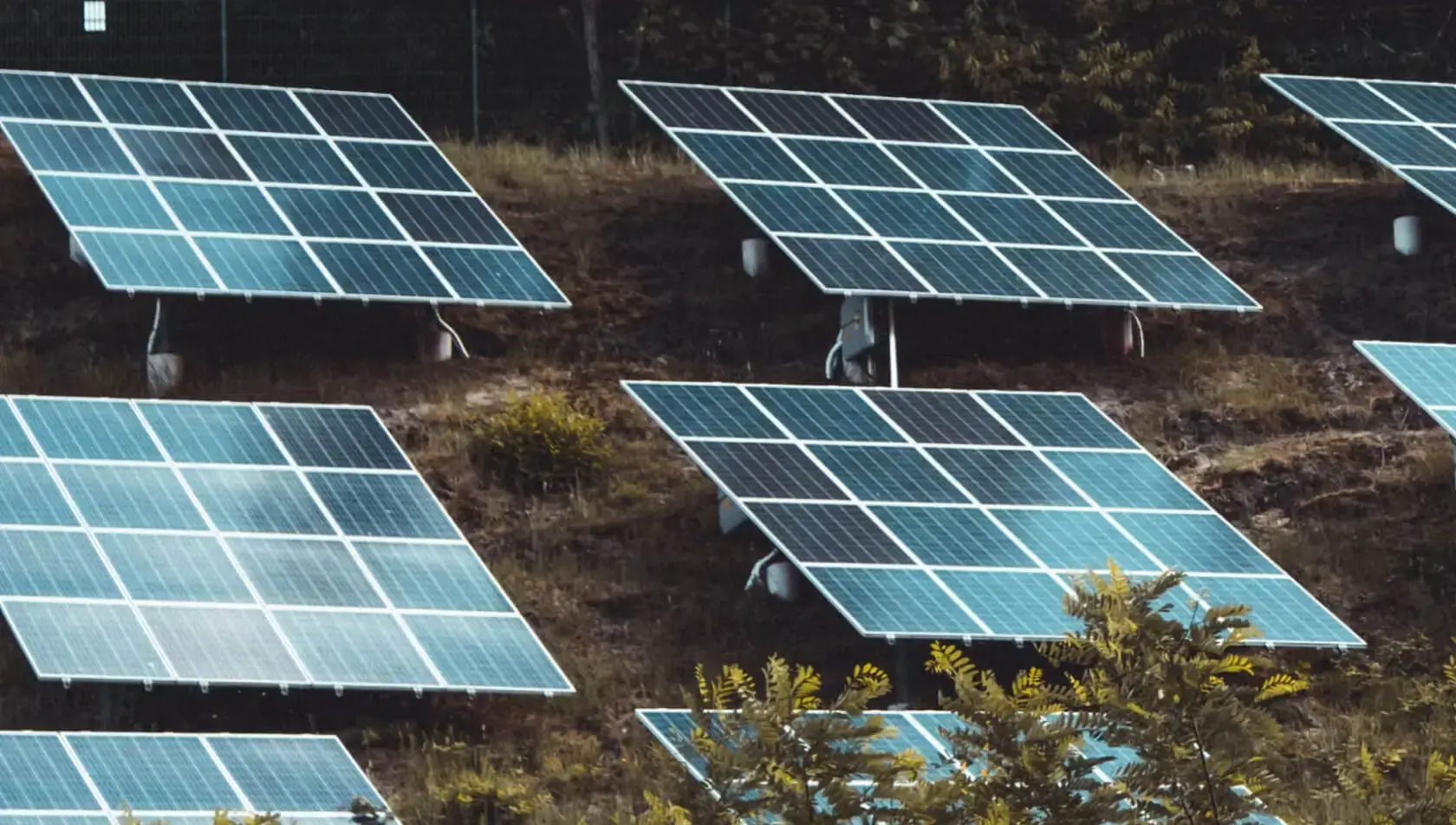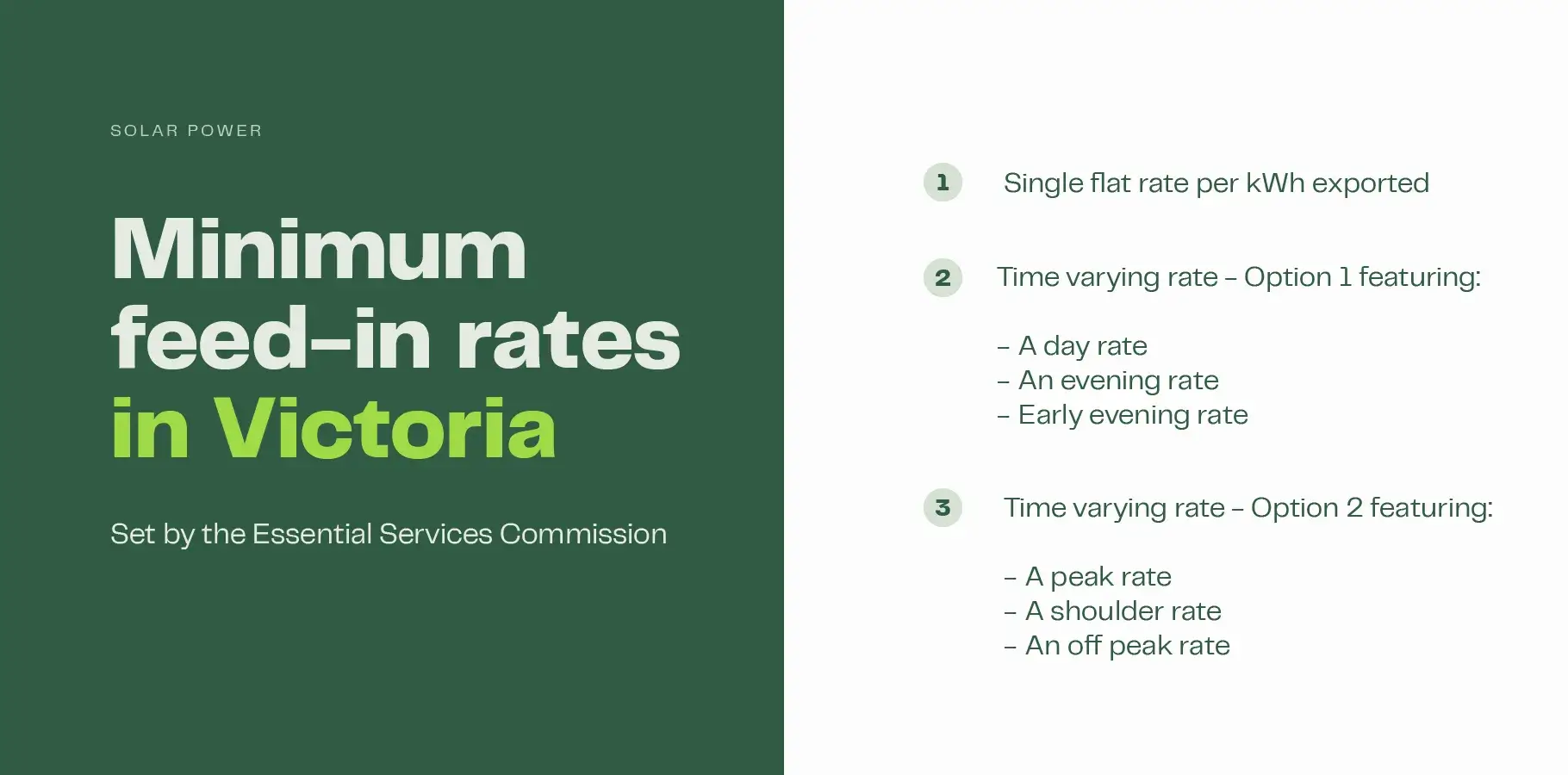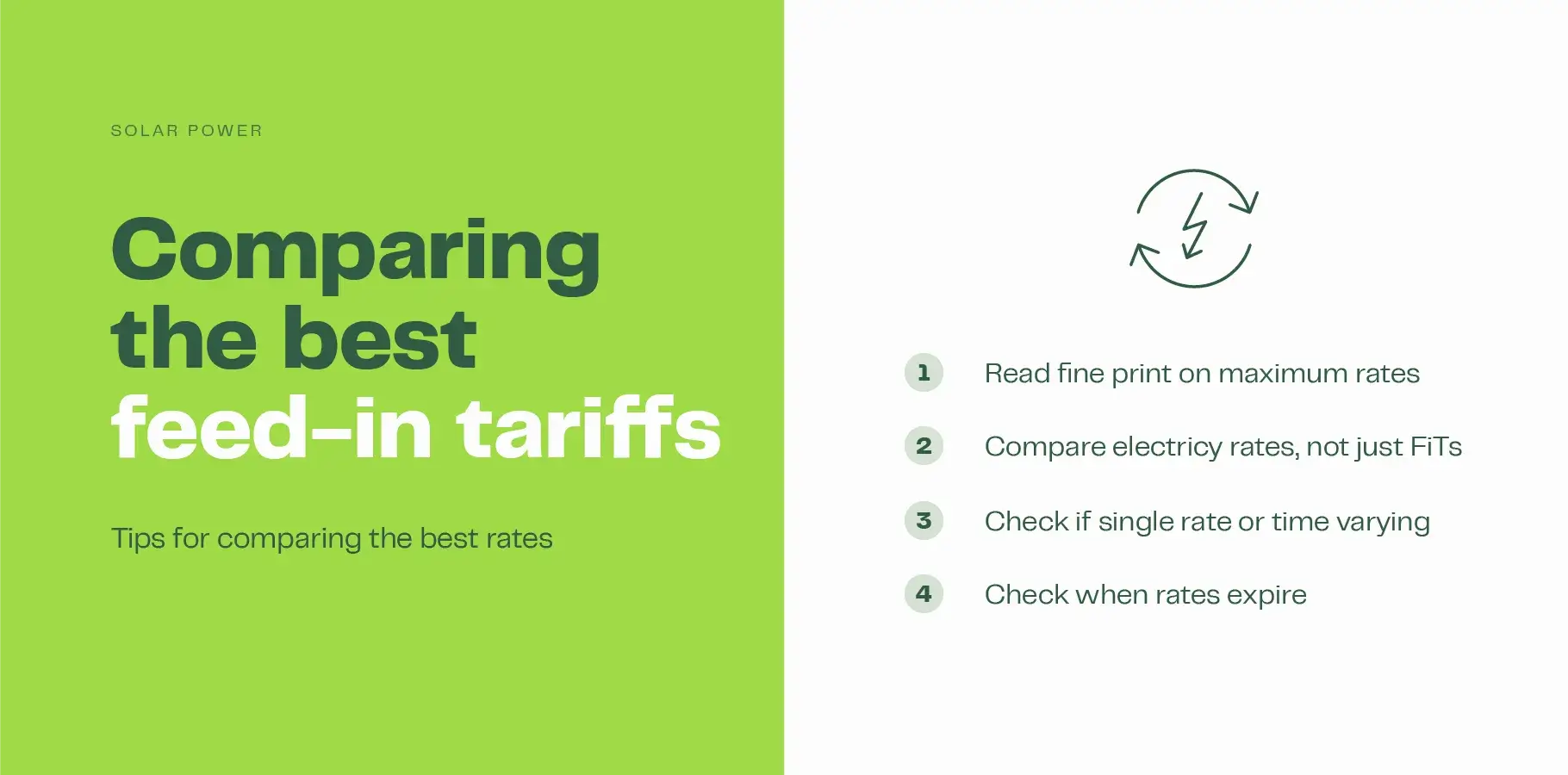Best VIC solar feed in tariff rates 2024
Last updated: September 2024
Reading time: 4 minutes
The solar feed-in tariff is a payment made to solar system owners from their chosen electricity supplier in exchange for excess solar energy that is produced and exported back to the grid.

For homes or businesses already equipped with solar, as well as those in the market in 2024, understanding the latest solar feed-in tariff rates in VIC is a key metric when calculating solar payback periods, weighing up solar system options, and choosing the best energy play for your property.
Table of contents
- Who sets the solar feed-in tariff in Victoria?
- Minimum feed-in tariff in Victoria 2024/25
- Timeline of solar feed-in tariffs in Victoria
- Best solar feed-in tariffs rates in VIC 2024
- How Victoria’s fit compares to other states & territories
- Is it worth going solar in Victoria?
Who sets the solar feed-in tariff in Victoria
The Essential Services Commission (ESC) sets a minimum FiT rate each year that energy companies must pay their customers for energy that is exported back to the grid.
In Victoria, the ESC reviews the minimum solar feed-in tariff each year in-line with market conditions and changes to solar weighted wholesale electricity prices.
While the ESC is responsible for setting the minimum solar feed-in tariff in Victoria, energy companies can (and do) offer more generous incentives in-line with demand, promotions, and sign-up incentives.
Demonstrated below in the timeline of solar feed-in tariffs in Victoria, the minimum solar feed-in tariff rates in Victoria continue to decline as adoption increases and the supply of excess energy to the grid – particularly during peak daylight hours, continues to grow.
Minimum feed-in tariff in Victoria 2024/25
The minimum feed-in tariff in Victoria for the 2024/25 financial year was set at 3.3 cents per kilowatt-hour by Victoria’s Essential Services Commission (ESC) back on February 27, 2024, coming into effect on 1 July 2024.
The 3.3c/kWh Minimum FiT for the 2024/25 financial year was a 32% decrease on the 4.9 cents per kilowatt- hour single rate minimum from the previous 2023/24 financial year.
The official Minimum feed-in tariff review 2024–25 documentation from the ESC outlined that the reduced flat rate minimum feed-in tariff for 2024-25 reflected “lower daytime wholesale electricity prices”.
While the ESC conceded that “wholesale electricity prices on average have increased in recent years”, the lower minimum FiT for the 2024/25 financial year was based on projections that prices would fall in the 2024/25 financial year.
The ESC cited an “increased number of households in Victoria with roof-top solar” exporting excess energy to the grid during daylight hours as a driving force behind the projected decline in electricity prices over the next 12-months.
While the minimum 3.3 cents per kilowatt-hour applies for the 2024-25 FY, the Essential Services Commission provides two options that retailers can offer solar customers for a flat rate feed-in tariff and/or a time-varying FiT for electricity exported back to the grid:
Time-varying minimum feed-in tariff Option 1
| Rate type | Applicable times |
|---|---|
| Overnight rate – 7.6c/kWh | Weekdays: 10pm to 7am |
| Weekends: 10pm to 7am | |
| Day rate – 2.8c/kWh | Weekdays: 7 am to 3 pm, 9 pm to 10 pm |
| Weekends: 7 am to 10 pm | |
| Early evening rate – 7.0c/kWh | Weekdays: 3 pm to 9 pm |
| Weekends: n/a |
Time-varying minimum feed-in tariff Option 2
| Rate type | Applicable times |
|---|---|
| Shoulder – 4.1c/kWh | Everyday: 9 pm to 10 am |
| Everyday: 2 pm to 4 pm | |
| Off-peak – 2.1c/kWh | Everyday: 10am to 2pm |
| Peak – 8.4c/kWh | Everyday: 4pm to 9pm |
Timeline of solar feed-in tariffs in Victoria
| FY | Minimum FiT (c/kWh) | Change from Previous FY |
|---|---|---|
| 2018-19 | 9.9 | -1.4c / kWh (-12.39%) |
| 2019-20 | 12 | +2.1c / kWh (+21.21%) |
| 2020-21 | 10.2 | -1.8c / kWh (-15.00%) |
| 2021-22 | 6.7 | -3.5c / kWh (-34.31%) |
| 2022-23 | 5.2 | -1.5c / kWh (-22.39%) |
| 2023-24 | 4.9 | -0.3c / kWh (-5.77%) |
| 2024-25 | 3.3 | -1.6c / kWh (-32.65%) |
Best solar feed-in tariffs rates in VIC 2024
While Victoria offers a minimum feed-in tariff rate of 3.3 cents per kilowatt-hour for the 2024/25 financial year, the actual rates offered by energy companies can be much higher in-line with demand and market conditions.
Energy companies choose the amount that they pay, but they cannot go lower than the mandated minimum rate of 3.3 cents per kilowatt-hour for the 2024/25 financial year. At the time of writing in September 2024, the best solar feed-in tariffs rates on offer in Victoria for 2024 are as follows:
| Retailer | Min Solar FiT (c/kWh) | Max Solar FiT (c/kWh) | Min / Max average |
|---|---|---|---|
| EnergyAustralia | 5.4c | 12c | 8.7c |
| Origin Energy | 3.3c | 10c | 6.65c |
| AGL | 3.3c | 10c | 6.65c |
| CovaU | 4.9c | 4.9c | 4.9c |
| Red Energy | 4.9c | 4.9c | 4.9c |
| Electricity in a Box | 4.9c | 4.9c | 4.9c |
| ENGIE | 3.3c | 5c | 4.15c |
| Energy Locals | 3.3c | 5c | 4.15c |
| Powershop | 3.3c | 5c | 4.15c |
| Sumo | 3.3c | 4.9c | 4.1c |
| Lumo Energy | 3.3c | 4.9c | 4.1c |
| Red Energy | 3.3c | 4.9c | 4.1c |
| Arcline by RACV | 4.1c | 4.1c | 4.1c |
| Indigo Power | 4c | 4c | 4c |
| Momentum Energy | 3.3c | 4c | 3.65c |
| OVO Energy | 3.3c | 3.3c | 3.3c |
| Dodo | 3.3c | 3.3c | 3.3c |
| Tango Energy | 3.3c | 3.3c | 3.3c |
| GloBird Energy | 3.3c | 3.3c | 3.3c |
| Alinta Energy | 3.3c | 3.3c | 3.3c |
| 1st Energy | 3.3c | 3.3c | 3.3c |
| Kogan Energy | 3.3c | 3.3c | 3.3c |
| Flow Power | 3.3c | 3.3c | 3.3c |
| Pacific Blue | 3.3c | 3.3c | 3.3c |
| Nectr | 3.3c | 3.3c | 3.3c |
How Victoria’s FiT rates compare to other states & territories
Victoria’s minimum FiT rate serves as a baseline for energy providers. Comparatively, energy providers in other states and territories around Australia are not bound to a government mandated minimum FiT and operate under free market conditions whereby they can set solar feed-in tariff rates based solely on market demand.
New South Wales (NSW)
- Range: NSW solar feed in tariff rates range from 5 to 15 cents per kilowatt-hour (c/kWh)
Key Providers:
- AGL: 5.0c – 15.0c
- Energy Australia: 7.6c
- Origin Energy: 7.0c – 20.0c
Queensland (QLD)
- Range: 5 to 16 cents per kWh
Key Providers:
- AGL: 5.0c - 15.0c
- Red Energy: 5.0c - 16.0c
- Energy Australia: 6.6c
South Australia (SA)
- Range: 3.5 to 20 cents per kWh
Key Providers:
- AGL: 6.0c
- Energy Australia: 8.5c
- Origin Energy: 6.0c – 20.0c
Western Australia (WA)
- Peak: 10.0c/kWh (3 pm to 9 pm)
- Off-Peak: 2.25 to 3.0c/kWh
- Providers: Synergy, Horizon Power
Tasmania (TAS)
- Fixed Rate: 10.869c/kWh
- Provider: Aurora Energy
Australian Capital Territory (ACT)
- Range: 6 to 15 cents per kWh
Key Providers:
- ActewAGL: 10.0c – 15.0c
- Energy Australia: 7.6c – 12.0c
Northern Territory (NT)
- Range: 8.3 to 11 cents per kWh
Key Providers:
- Rimfire Energy: 11.0c
- Jacana Energy: 8.3c
Is it worth going solar in Victoria?
With the minimum FiT in Victoria continuing to decline, it begs the question – is it still worth investing in solar for your home?
The fact is this: solar feed-in tariffs rates are just one metric that you should be looking at when weighing up solar and projected payback periods. As adoption increases, the minimum FiT in Victoria is likely to continue to decline.
However, as adoption increases, so too do the solar hardware options. Increasingly affordable solar systems coupled with competitive installation costs mean that while the minimum feed-in tariffs rates continue to decline, so too do the upfront costs of setting up solar for your home or business.
When weighing up the upfront costs and projected payback period for solar in Victoria, it’s important to weigh up all of the metrics. Your energy consumption, your location, and a myriad of other factors will all come into play when making your decision. For more resources and a more detailed way to calculate your upfront costs, check out our free solar calculator and receive a free, no-obligation quote for solar for your home or business today.
- VIC Feed-in tariff overview
- Who sets the solar feed-in tariff in Victoria
- Minimum feed-in tariff in Victoria 2024/25
- Timeline of solar feed-in tariffs in Victoria
- Best solar feed-in tariffs rates in VIC 2024
- How Victoria’s FiT rates compare to other states & territories
- Is it worth going solar in Victoria?

Are you ready to compare solar quotes?
Get 3 free quotes and start your solar journey today.
Get free quotes

